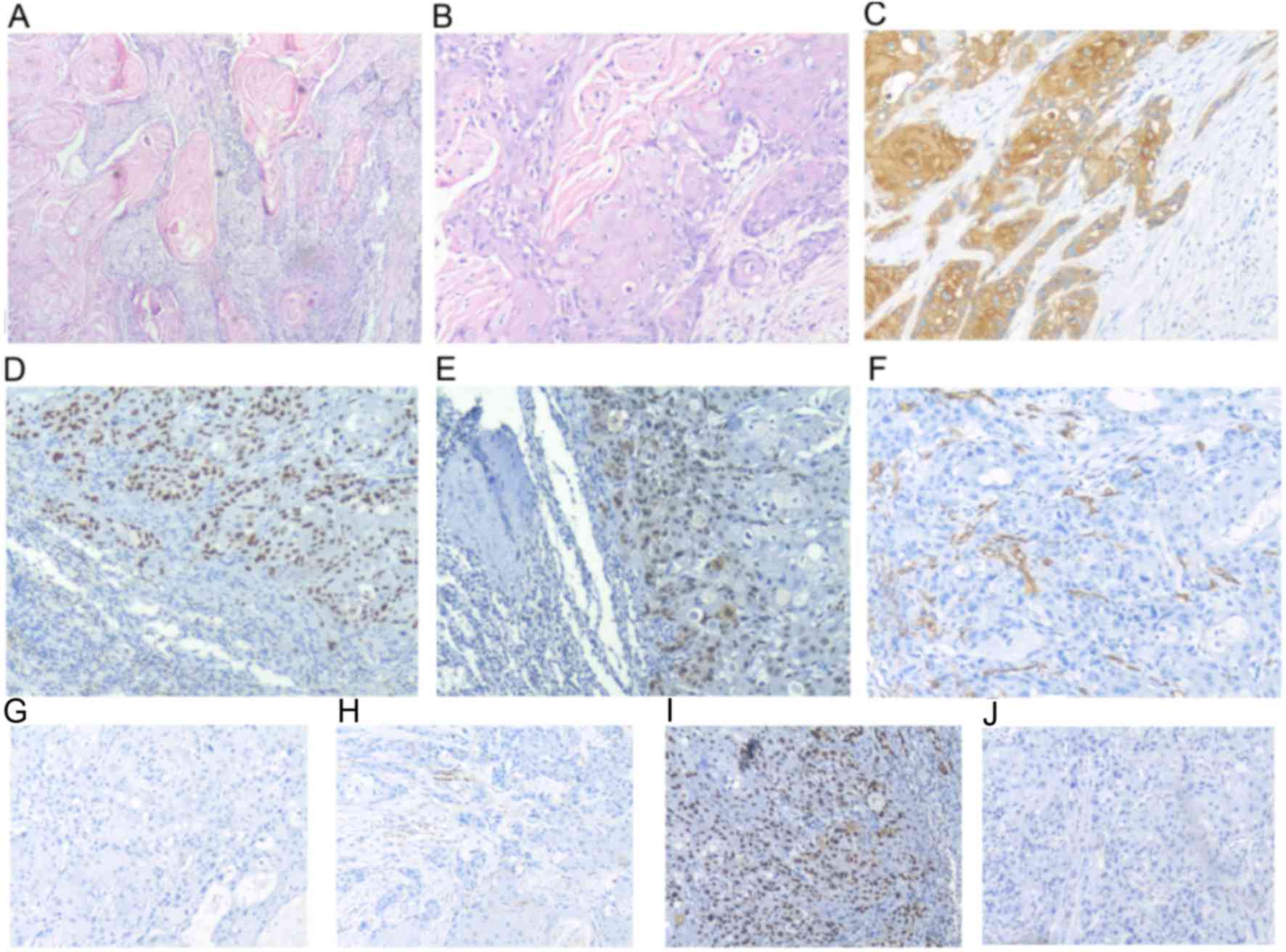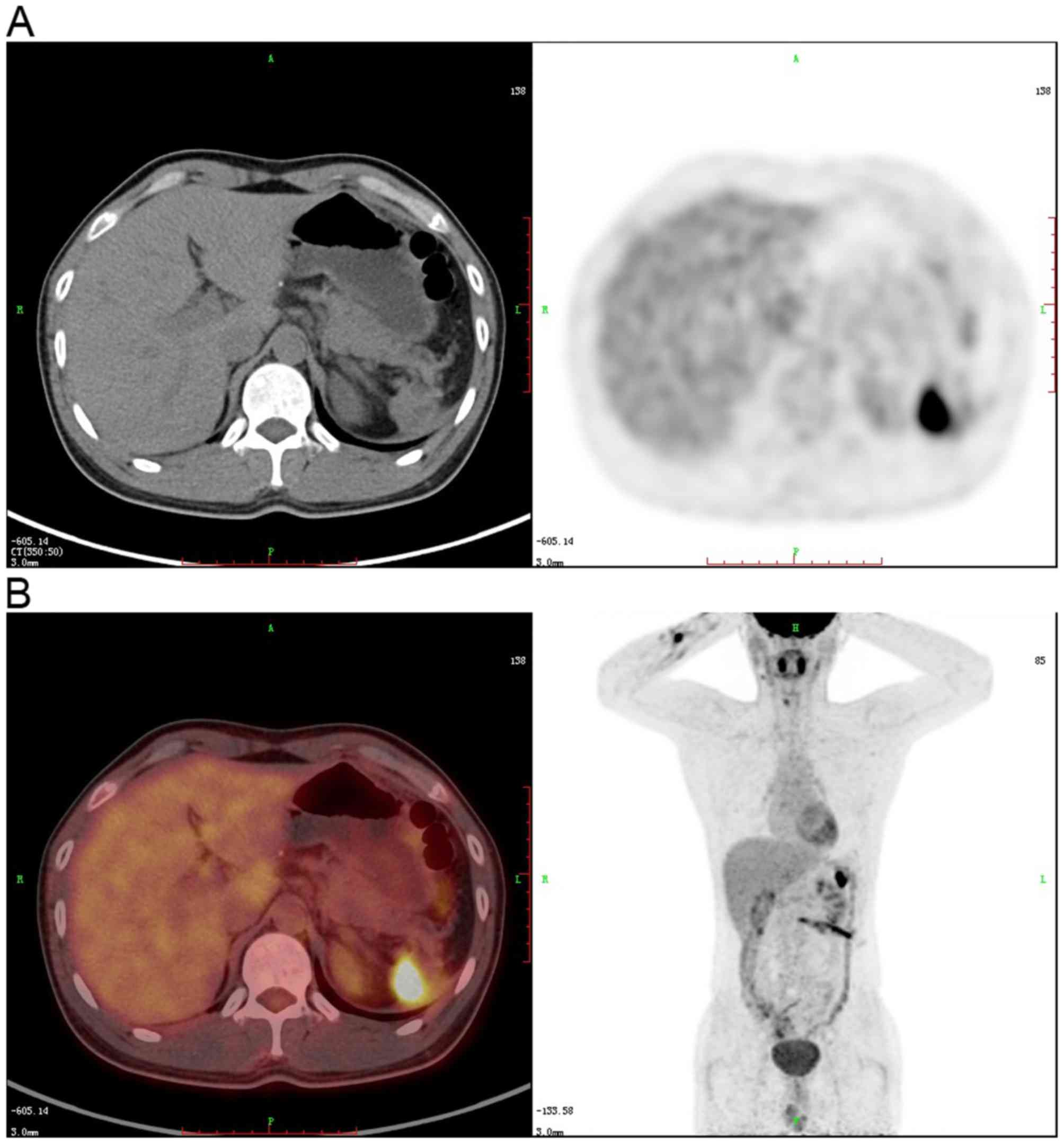Squamous cell carcinoma of the spleen: A case report
- Authors:
- Published online on: July 6, 2018 https://doi.org/10.3892/ol.2018.9095
- Pages: 3973-3975
Abstract
Introduction
The spleen is an important immune organ that has antitumor activity and an abundance of blood cells, a small amount of which are afferent lymphatic cells. All of these features contribute to a relatively low tumor incidence, accounting for only 0.03% of all types of tumors in humans (1). Splenic tumors can be divided into three types: Benign, malignant and metastatic, all of which are rare. The malignant tumors that occur in the spleen are typically lymphosarcoma, reticulosarcoma, angiosarcoma and fibrosarcoma (2). The most common primary lesion sites with splenic metastases are, in order of decreasing frequency, the lungs, stomach, pancreas, liver and colon (3). As has been noted, primary tumors in the spleen are usually of lymphatic or vascular origin, whereas an epithelial tissue origin is rare. To the best of our knowledge, there has only been one previous case report of metastatic adenocarcinoma of the spleen, with no primary lesion found by general examination, exploratory laparotomy or postoperative follow-up (4). However, single squamous cell carcinoma of the spleen with no identified lesion in a different organ has not been previously reported. The study aims to share this exception and demonstrate its poor response to chemotherapy and only a 14-month overall survival despite receiving surgery.
Case report
Case presentation
A 28-year-old male without a history of trauma was admitted to the Second Xiangya Hospital in February 2015, Central South University (Changsha, China) on an emergency basis due to a sudden pain in the left upper abdomen. There were no clear abnormalities in the physical examination, aside from tenderness, with no rebound pain, in the left upper abdomen. An abdominal computed tomography (CT) scan suggested that there was a lesion on the spleen, which may have been caused by a rupture of a splenic hemangioma. Subsequently, exploratory laparotomy revealed that there was a palpable hard mass on the surface of the spleen, which invaded the retroperitoneum. The patient subsequently received an excision of the splenic lump.
Postoperative pathological analysis
The postoperative pathological examination revealed a 6×7×8-cm mass, with partial membrane invasion, which is an indicator of well to moderately differentiated squamous cell carcinoma (Fig. 1). The results of immunohistochemistry were as follows: Thyroid transcription factor-negative, cytokeratin 7-negative, p63-positive, p40-positive, cluster of differentiation 34-negative, creatine kinase-positive, leucocyte common antigen-negative and p53-positive (Fig. 1).
The fluorescence microscope (Nikon Eclipse 55i; Nikon Corporation, Tokyo, Japan) was used to observe the slides of the tumor.
PET-CT
A postoperative systemic PET-CT scan indicated that nodular soft tissue located in the spleen area, next to the diaphragm, with an abnormal increase in glucose metabolism, was a residual postoperative effect. Apart from this, there was no abnormal increase in glucose metabolism according to the whole-body PET-CT imaging (Fig. 2).
Treatment
Subsequent to 4 cycles of chemotherapy (120 mg docetaxel (day 1) and 40 mg cisplatin (day 1–3) were administered intravenously; 21 days comprised a single cycle), the patient underwent another PET-CT examination, which showed that the previous nodular soft tissue had increased in size (57×44 mm vs. 23×22 mm; SUVmax 13.7 vs. 6.4). Additionally, new nodules appeared with increased glucose metabolism in the clearance between the curvatura gastrica major and the diaphragm, and enlarged lymph nodes were present in the left side of the abdominal aorta, which were considered metastases, while no abnormalities were found in the other organs. Subsequently, the patient received a single circle of second-line chemotherapy (Gemcitabine, administered at 1,800 mg intravenously on day 1 and 8, or Capecitabine, administered at 1,500 mg orally twice a day on day 1–14). However, the patient was reluctant to proceed to the second cycle of treatment, therefore the treatment ceased.
Follow-up
The patient was discharged in good general condition in August 2015. Afterwards, the patient elected to use a Chinese herbal treatment. Since February 2016, the patient begun to suffer from bloating and abdominal pain due to the intestinal obstruction resulting from peritoneal metastasis and subsequently, the patient succumbed to cachexia in April 2016, 14 months after diagnosis.
Discussion
As previously referenced, the analysis of Zhan (4) of 194 cases of spleen tumors categorized 95 cases as primary malignant lymphoma, 45 as metastatic tumors and the remaining as mesenchymal malignant tumors, including angiosarcoma, malignant fibrous sarcoma and liposarcoma. However, none were identified as squamous cell carcinoma. In the data, a median survival of stage I–III malignant lymphomas are 30, 18, and 2 months (4). However, in the case outlined by the present study, no metastases was detected at diagnosis and the overall survival overall survival was merely 14 months.
The spleen consists of a membrane, the trabeculae, white pulp, red pulp and the marginal zone, which are all mesenchymal (5). While squamous cell carcinoma is a malignant tumor that originates from the epidermis or adnexa, its cancer cells have various degrees of diversification, which is common in the areas covered by squamous epithelia, including the skin, mouth, esophagus, cervix and vagina, or in cases of immune suppression, such as in organ transplant patients (6). In addition, certain regions of the body, including the bronchi, bladder and renal pelvis, that do not have a squamous epithelial covering, can also develop squamous cell carcinoma by squamous metaplasia (7). Notably, there is no epithelial tissue in the spleen. Therefore, the cause of squamous cell carcinoma of the spleen is considered to be as follows. First, metastatic squamous cell carcinoma should be taken into consideration. False-negative PET-CT examinations can occur when the size of the primary tumor is too small, or when the metabolism is not active (8). Even subsequent to disease progression and tumor metastasis to the peritoneum and the abdominal cavity, the primary tumor is occasionally still not observed upon review of the PET-CT scan results. The other possible mechanism may be, to a certain degree, similar to endometriosis (9). Due to the abundant blood flow through the spleen, fragments of epithelial tissue from other areas of the body enter the spleen with the blood and implant in it. Stimulated by inflammation or hormones over time, squamous metaplasia can then occur (7), followed by atypical hyperplasia, and finally, squamous cell carcinoma develops. Therefore, the origin and the mechanism of the tumor in the present case study remains unknown, and due to the reluctance of the patient, imaging data or a biopsy of the metastatic lesions were not obtained.
In conclusion, the present study details a case of squamous cell carcinoma of the spleen, where no primary lesion was found, which to the best of our knowledge, has not been reported previously. Furthermore, in this case, the survival rate was notably short when compared with other malignant metastasis of the spleen and therefore provides potentially useful information pertaining to the response for standard treatment and the prognosis of the splenic squamous cell carcinoma for a single case.
Acknowledgements
Not applicable.
Funding
No funding was received.
Availability of data and materials
The authors declare that materials described in the manuscript, including all relevant raw data, will be freely available to any scientist wishing to use them for non-commercial purposes, without breaching participant confidentiality from the department of Oncology, Pathology and Radiology of The Second Xiangya Hospital of Central South University.
Authors' contributions
XL was in charge of the patient, decided the treatment and revised the manuscript critically for important intellectual content. FM assisted with data collection and analysis. ZJ came up with the idea, planned out the article and wrote the manuscript.
Ethics approval and consent to participate
This study was approved by the Ethics Committee of The Second Xiangya Hospital of Central South University (Changsha, China).
Consent for publication
Written patient consent was obtained. The IRB name is the Ethics Committee of The Second Xiangya Hospital of Central South University, located in the Second Xiangya Hospital of Central South University, Changsha, Hunan, China.
Competing interests
The authors declare that they have no competing interests.
References
|
Coon WW: Surgical aspects of splenic disease and lymphoma. Curr Probl Surg. 35:543–646. 1998. View Article : Google Scholar : PubMed/NCBI | |
|
Badiani R, Schaller G, Jain K, Swamy R and Gupta S: Angiosarcoma of the spleen presenting as spontaneous splenic rupture: A rare case report and review of the literature. Int J Surg Case Rep. 4:765–767. 2013. View Article : Google Scholar : PubMed/NCBI | |
|
Lam KY and Tang V: Metastasic tumors to the spleen: A 25-year clinicopathologic study. Arch Pathol Lab Med. 124:526–530. 2000.PubMed/NCBI | |
|
Zhan S: Spleen cancer of 194 cases. Chin J Gen Surg. 12:183–184. 1997.(In Chinese). | |
|
Lewis JT, Gaffney RL, Casey MB, Farrell MA, Morice WG and Macon WR: Inflammatory pseudotumor of the spleen associated with a clonal Epstein-Barr virus genome. Case report and review of the literature. Am J Clin Pathol. 120:56–61. 2003. View Article : Google Scholar : PubMed/NCBI | |
|
Singh MK and Brewer JD: Current approaches to skin cancer management in organ transplant recipients. Semin Cutan Med Surg. 30:35–47. 2011. View Article : Google Scholar : PubMed/NCBI | |
|
Clouston D and Lawrentschuk N: Metaplastic conditions of the bladder. BJU Int. 2 Suppl 112:27–31. 2013. View Article : Google Scholar | |
|
Padma S, Sundaram PS and George S: Role of positron emission tomography computed tomography in carcinoma lung evaluation. J Cancer Res Ther. 7:128–134. 2011. View Article : Google Scholar : PubMed/NCBI | |
|
Meola J, Rosa e Silva JC, Dentillo DB, da Silva WA Jr, Veiga-Castelli LC, Bernardes LA, Ferriani RA, de Paz CC, Giuliatti S and Martelli L: Differentially expressed genes in eutopic and ectopic endometrium of women with endometriosis. Fertil Steril. 93:1750–1773. 2010. View Article : Google Scholar : PubMed/NCBI |











